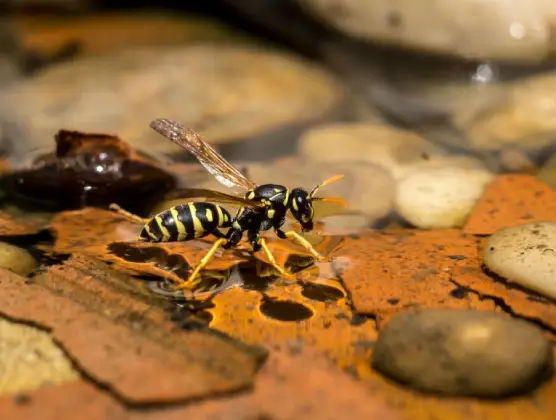Wasps and different varieties of wasps, such as spider hunting wasps or spider wasps in Australia, are a common phenomenon. Although wasps can be beneficial to crops, they are also known to create more problems than the good they do! Read on, to learn more about spider wasps in Australia.
The spider wasp most commonly encountered. This is a very large black wasp with orange wings and legs and a broad orange band around its abdomen. It holds its wings up when resting but flicks them when it hops and runs about on its long legs.
Spider wasps are solitary wasps. They prey on spiders to feed their larvae or they parasitise other spider wasps. They do not form colonies to defend nests and are not aggressive. Adult spider wasps are commonly found on flowers and either on the ground or hovering above it in search of prey.

Wasp nests usually look like papery grey balloons. Most wasp nests are made from brown paper. Foraging wasps create this brown paper by chewing things like plant particles and wood. Wasp nests’ appearance can vary based on the species that built them; they can be closed or open-faced.
These flying insects make their nests from saliva and chewed wood pulp, giving them particular papery walls. They are usually built in sheltered areas with easy access outdoors, like roof spaces, wall cavities, bird boxes, hollow trees, under eaves, garages, or sheds. Ground nests, are usually built in hidden locations like dense trees or bushes.
Treating a nest early is essential to reduce the threat of harmful stings, which can cause an allergic reaction. A sudden increase in wasp activity around your garden is a strong indication that there may be a nearby nest.
Look for nest structures hanging from tree branches, shrubs, or under eaves of buildings. They may resemble papery structures or enclosed combs depending on the wasp species. Wasps repeatedly entering and exiting a particular spot, can indicate the presence of a nest nearby. Certain wasps, like paper wasps, create nests by chewing wood fibres and mixing them with saliva.
Approach the nest slowly and quietly at night time, to play safe. Take a garbage bag and slowly cover the wasp nest. Detach the wasp nest from the tree or wall it is attached to and seal the bag. Then, place the garbage bag in a properly sized garbage can or drum that has a tight-fitting lid, preferable far away from your premises.
Vinegar is an effective and easily available method for removing wasps. Use two cups of apple cider vinegar, two cups of sugar, and one cup of water to make a DIY wasp repellent. Mix the mixture completely before placing it near the nest to attract and kill wasps!
When you need to exercise control against spider wasps or when you sight a spider wasp nest, you can try out some simple measures of spider wasp removal. Use the garden hose to spray water and drive the wasp away, or swat the wasp with a rolled-up newspaper or fly swatter.
Pesticides are not recommended, especially where insecticide deposits could be picked up by honeybees and carried back to their hive. Since it is unlikely that more than one spider wasp is encountered by the homeowner, doing nothing except letting the wasp escape is recommended.
The best and safest option would be to avail expert assistance, call pest management professionals who will advise and provide you with spider wasp removal services in Melbourne and other recommendations.